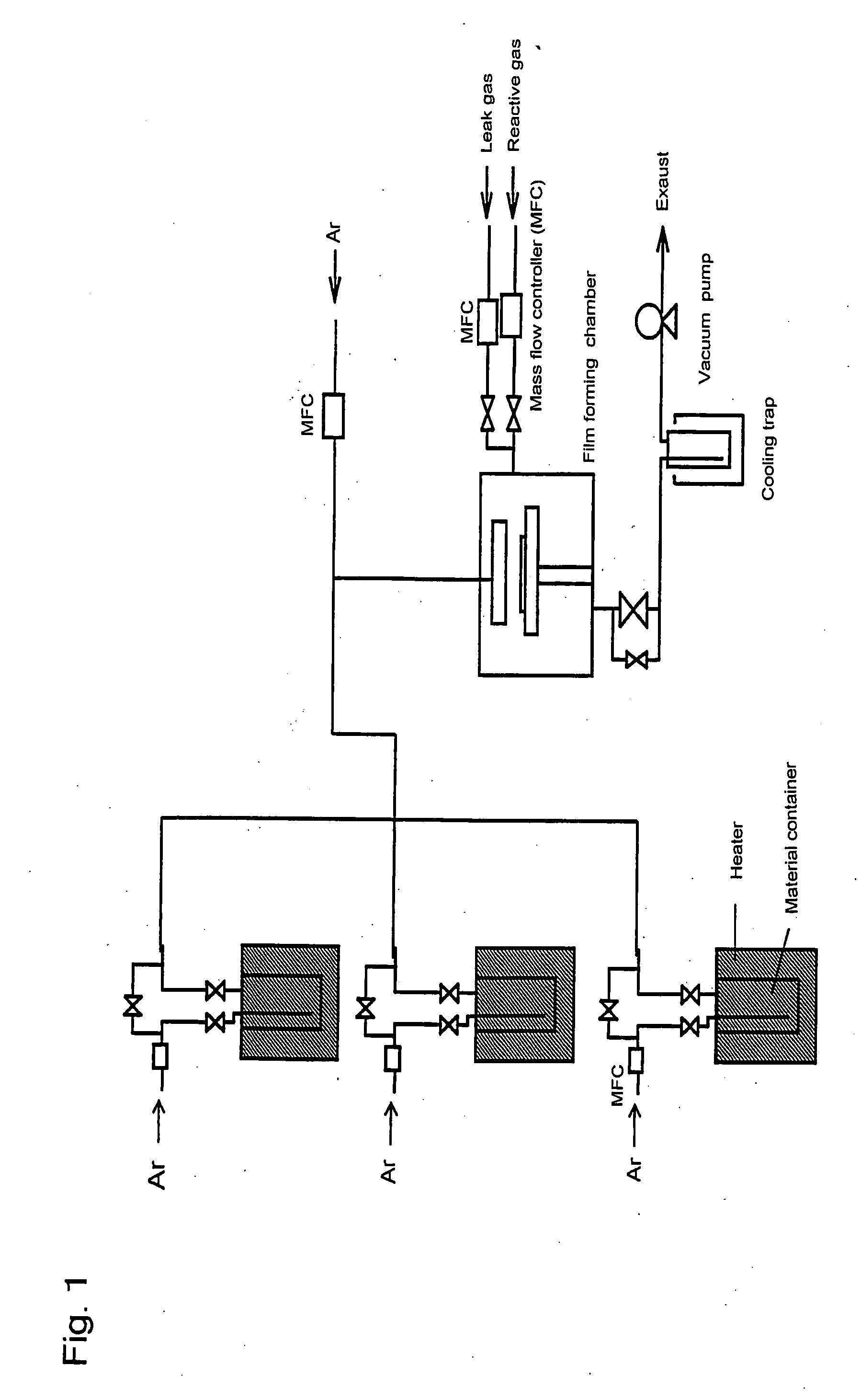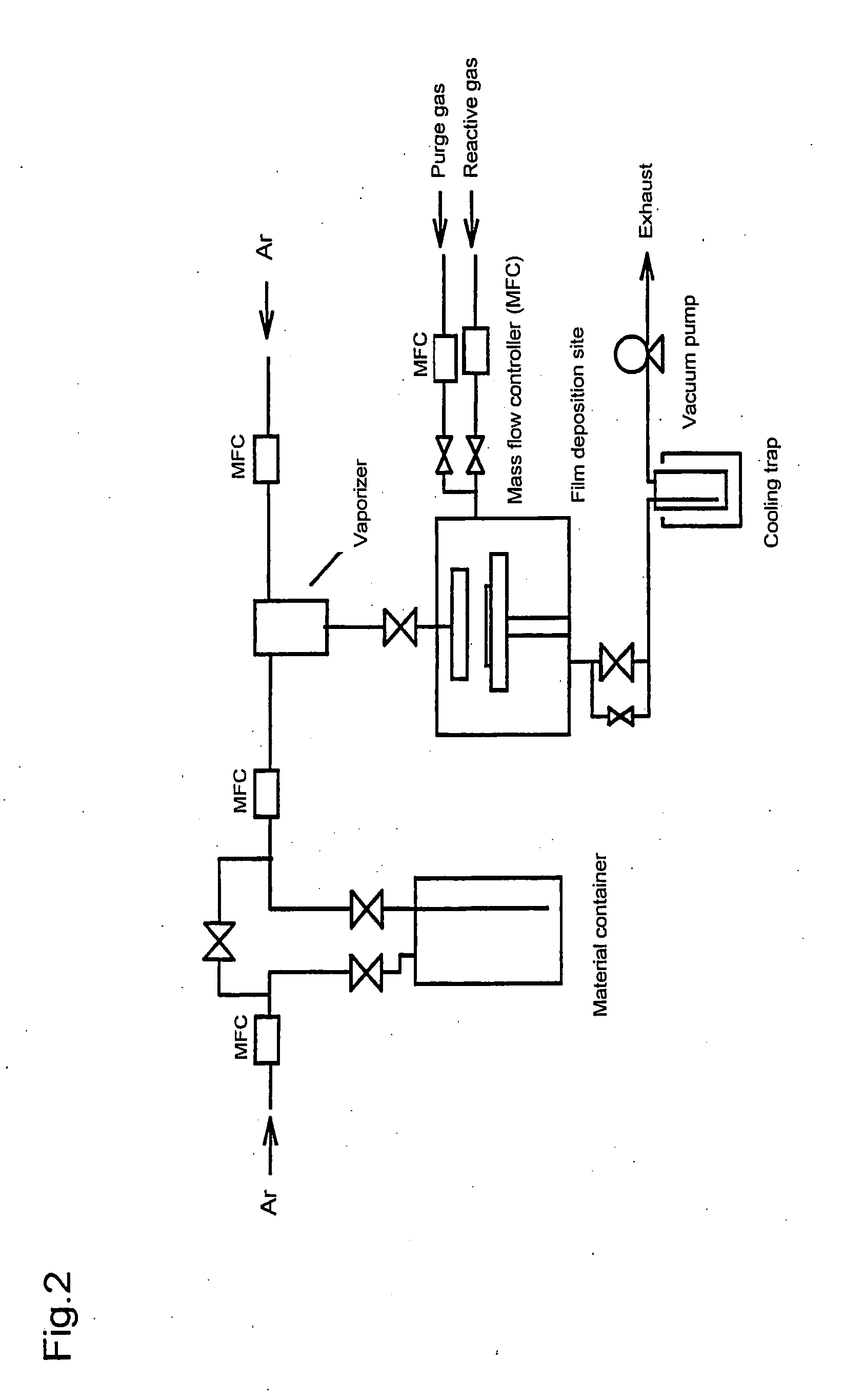Metal compound, material for thin film formation, and process of forming thin film
a metal compound and film technology, applied in the field of metal compound, material for thin film formation, and process of forming thin film, can solve the problems of lead, titanium or zirconium not meeting these requirements, and achieve the effect of reducing the number of metal compounds
- Summary
- Abstract
- Description
- Claims
- Application Information
AI Technical Summary
Benefits of technology
Problems solved by technology
Method used
Image
Examples
example 1
Preparation of Compound No. 1
[0041] In a light-protected flask were put 0.478 mol of lead dichloride, 2000 ml of dehydrated diethyl ether, and 0.935 mol of bis(trimethylsilyl)aminolithium and stirred at 25° C. for 24 hours in a dry argon atmosphere. The diethyl ether solvent was removed by evaporation, and 3000 ml of dehydrated hexane was added to the residue. The solid phase was removed by filtration. To the resulting solution was added dropwise 1.03 mol of 1-dimethylamino-2-methyl-2-propanol, followed by stirring at 25° C. for 24 hours. Hexane and by-produced hexamethyldisilazane were removed by distillation. From the fraction at 13 to 15 Pa and a tower top temperature of 90° to 95° C. was obtain white crystals in a yield of 38%, which were further purified by distillation under reduced pressure to obtain crystals. The recovery of the purification was 90%. The resulting crystals were identified to be the title compound, compound No. 1. The analytical values of the crystals were a...
example 2
Preparation of Compound No. 13
[0045] Into a reaction flask were dropped 0.100 mol of tetra(2-propoxy)titanium, 60 ml of dehydrated xylene, and 0.440 mol of 1 -dimethylamino-2-methyl-2-propanol and allowed to react at 135° C. for 18 hours in a dry argon atmosphere while removing by-produced 2-propanol by evaporation. Xylene was removed by evaporation, and the residue was distilled under reduced pressure. A pale yellow liquid was obtained from the fraction at 5 to 7 Pa and a tower top temperature of 122° to 124° C. in a yield of 48%. The pale yellow liquid was purified by distillation under reduced pressure to obtain a liquid. The recovery of the purification was 94%. The resulting liquid was identified to be the title compound, compound No. 13. The results of analyses on the liquid are shown below.
Results of analyses:
[0046] (1) Elemental analysis (metal analysis: ICP-AES) Ti: 9.43% by mass (calcd.: 9.34%)
[0047] (2) 1H-NMR (solvent:deuterobenzene) (chemical shift:multiplicity:num...
example 3
Preparation of Compound No. 25
[0049] Into a reaction flask were dropped 0.100 mol of Zirconium(IV) isopropoxide isopropanol complex, 60 ml of dehydrated xylene, and 0.440 mol of 1-dimethylamino-2-methyl-2-propanol and allowed to react at 135° C. for 10 hours in a dry argon atmosphere while removing by-produced 2-propanol by evaporation. Xylene was removed by evaporation, and the residue was distilled under reduced pressure. A colorless liquid was obtained from the fraction at 8 to 10 Pa and a tower top temperature of 139° to 140° C. in a yield of 53%. The colorless liquid was purified by distillation under reduced pressure to obtain a liquid. The recovery of the purification was 92%. The resulting liquid was identified to be the title compound, compound No. 25. The results of analyses on the liquid are shown below.
Results of analyses:
[0050] (1) Elemental analysis (metal analysis: ICP-AES) Zr: 16.8% by mass (calcd.: 16.4%)
[0051] (2) 1H-NMR (solvent:deuterobenzene) (chemical shif...
PUM
| Property | Measurement | Unit |
|---|---|---|
| pressure | aaaaa | aaaaa |
| pressure | aaaaa | aaaaa |
| temperature | aaaaa | aaaaa |
Abstract
Description
Claims
Application Information
 Login to View More
Login to View More - R&D
- Intellectual Property
- Life Sciences
- Materials
- Tech Scout
- Unparalleled Data Quality
- Higher Quality Content
- 60% Fewer Hallucinations
Browse by: Latest US Patents, China's latest patents, Technical Efficacy Thesaurus, Application Domain, Technology Topic, Popular Technical Reports.
© 2025 PatSnap. All rights reserved.Legal|Privacy policy|Modern Slavery Act Transparency Statement|Sitemap|About US| Contact US: help@patsnap.com



